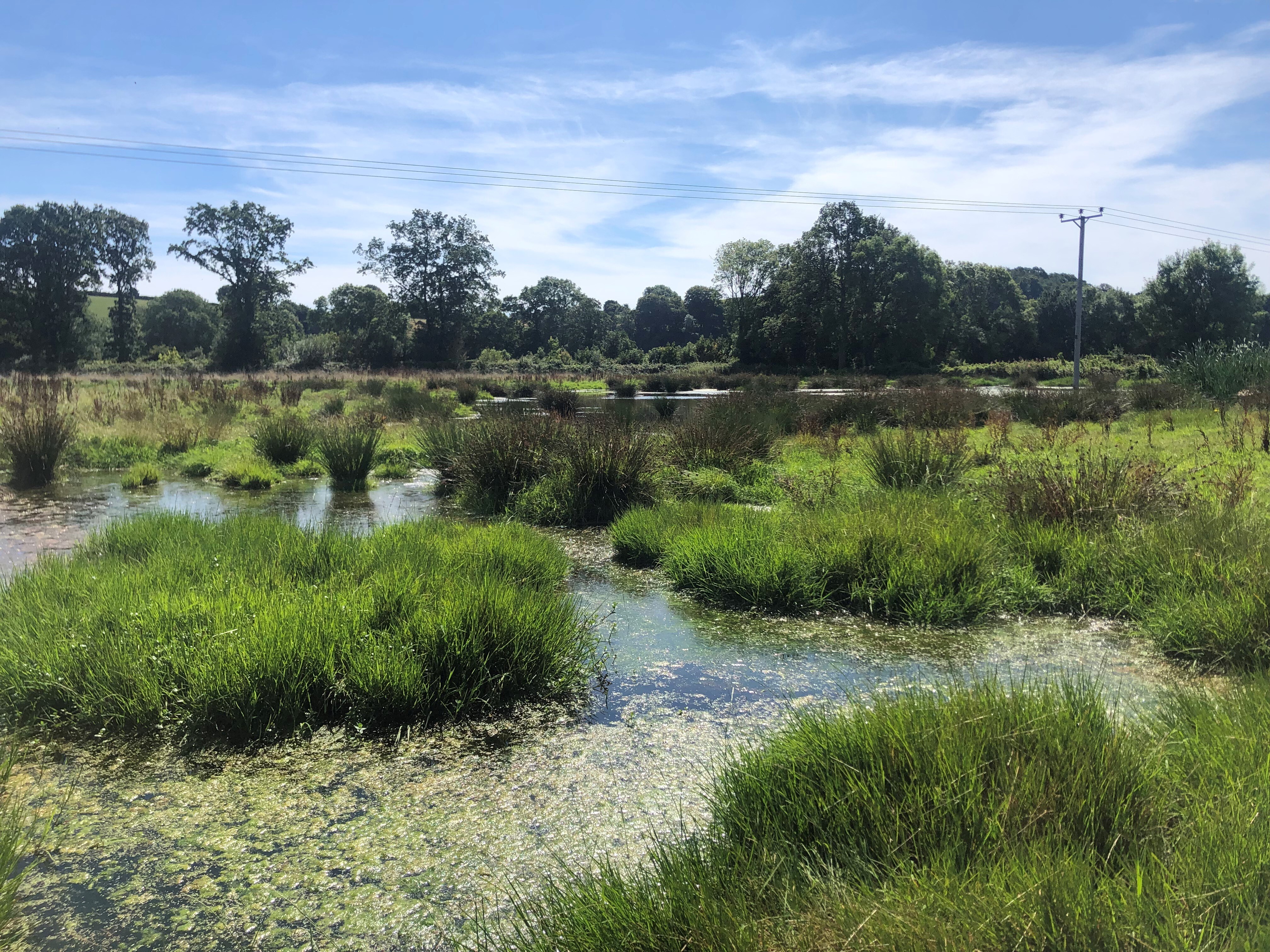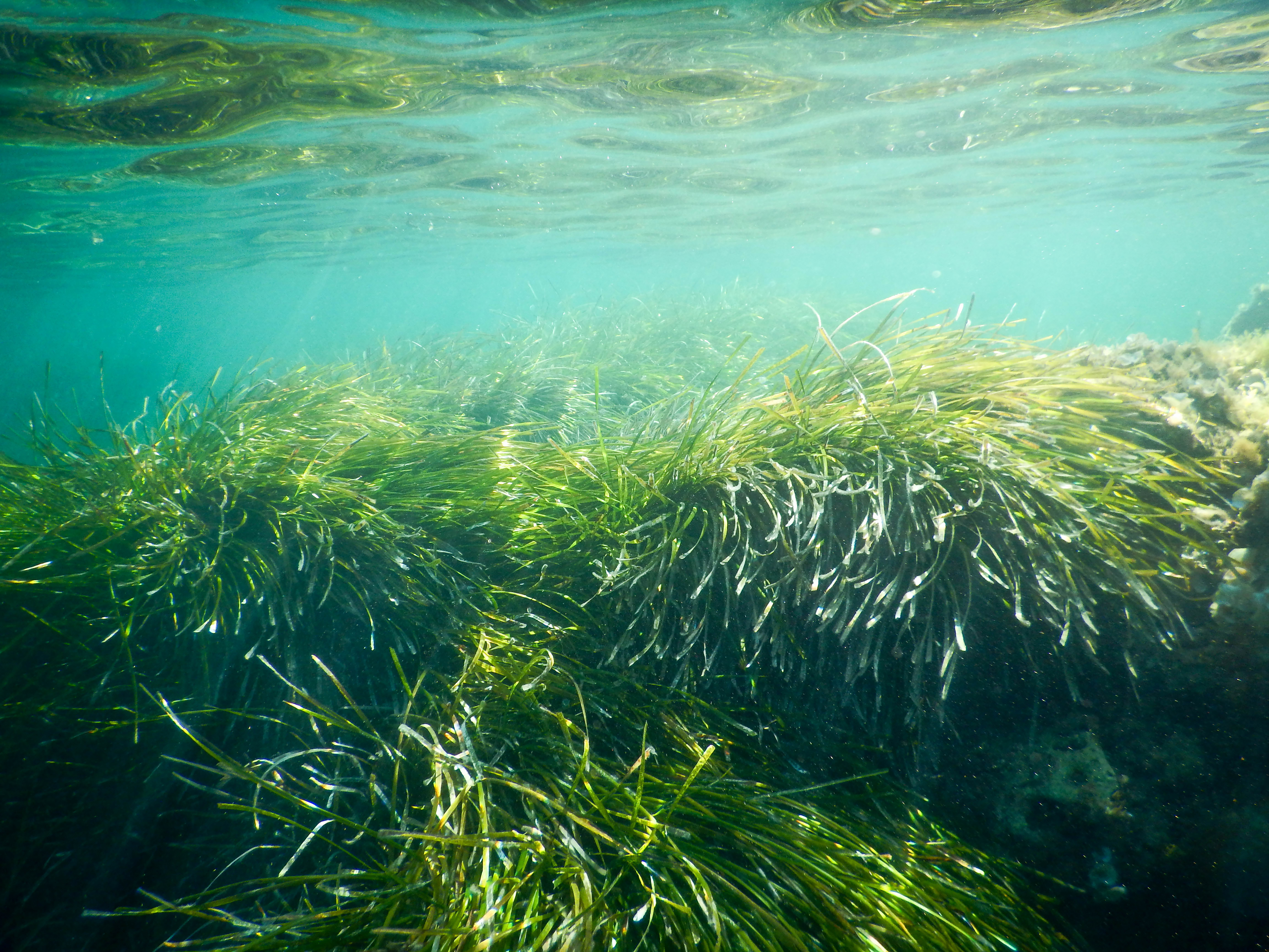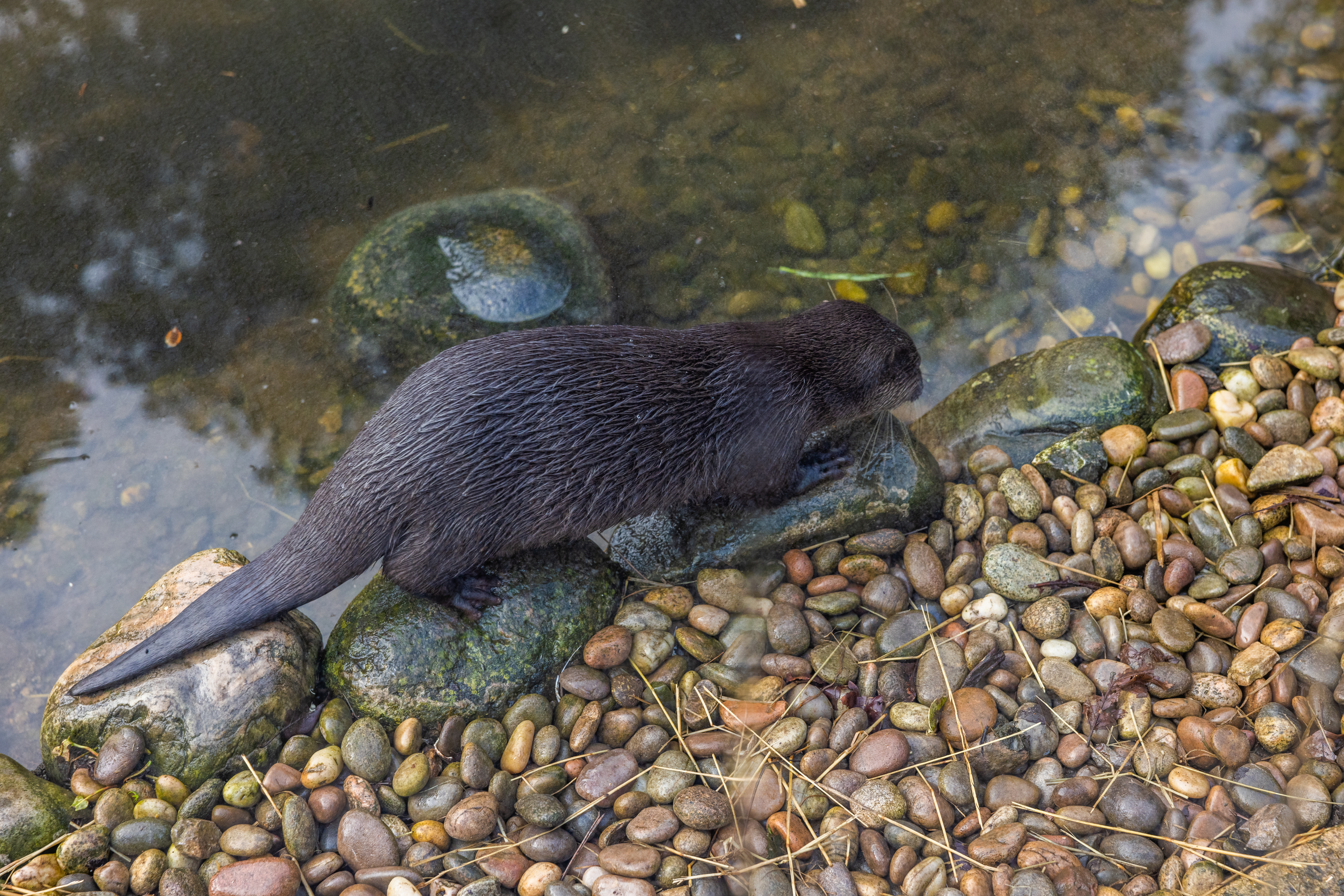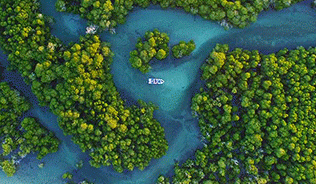environmental SCIENTIST | Britain's Natural Capital | March 2024
Rob Stoneman reflects on what we have achieved and how much we still need to do to rebalance nature.
What is rewilding?
Summer 2023, South Devon. All around is a typical landscape of rolling lowlands: bright-green fertilised pasture with the occasional field of maize or potato. At the edge of one field, a line of trees marks a watercourse. Like most British streams and rivers, this one had been channelised and was now barely discernible – a ditch acting as a receptor for the field drains that kept this once-floodplain land dry enough for pastoral or arable farming. In truth, any understanding of what that land had once been, written or passed down through the generations, has been lost. The scene is green and pleasant, but largely devoid of wildlife.
The next field over is flooded with shallow water and covered with pink and purple wetland flowers. A green sandpiper angles across it; a heron rises lazily into the air; the little egrets walk out of view to hunt for frogs and fish; and all around damselflies and dragonflies patrol the scene in abundance. This transformation has come about in just 18 months, to the delight of nature lovers and to the acquiescence and acceptance of the landowner who switched the field from state-subsidised pasture to a state-subsidised agri-environment agreement for nature restoration. The restoration works required no planning permission, no negotiations, no impact assessments; it cost nothing and was effected almost immediately. The ecological engineering that created such an impressive recovery of wildlife, re-naturalising the stream and reconnecting it to its floodplain for perhaps the first time in centuries, had nothing to do with human endeavour. Ecological balance was restored simply by allowing beavers to migrate up this small tributary of the River Otter – a wonderful example of rewilding. But what is rewilding? The first mention is traced to a 1990 Newsweek article, and later clarified to define it as a ‘scientific argument for restoring big wilderness based on the regulatory roles of large predators’ and emerged from work in the USA focusing on the 3Cs of rewilding: cores, corridors and carnivores.1,2 This definition resulted from a cascade of ecological impacts arising from the reintroduction of wolves to Yellowstone National Park, which altered the behaviour of elk – one of the big wild herbivores in the park. Elk, or wapiti (Cervus canadensis), favoured the open plain to the riverside for its 360-degree escape route – as opposed to the 180-degree route on the riverbank – allowing riverine vegetation to rebuild. In turn, more woody vegetation led to more beavers creating new wetlands and to more bison browsing the woody vegetation on the open plain, substantially increasing the diversity and abundance of wildlife in the park.3
In Europe, rewilders have taken a broader approach, perhaps reflecting that large wilderness areas such as those found across North America, Africa and Australasia do not really exist in Europe. A useful European definition of rewilding is a ‘strategy [that] aims to restore self-sustaining and complex ecosystems, with interlinked ecological processes that promote and support one another while minimising or gradually reducing human interventions’.4 This definition is based on three critical components of natural ecosystem dynamics – trophic complexity, stochastic disturbance and dispersal – on the basis that the ‘restoration of these processes, and their interactions, can lead to increased self-sustainability of ecosystems and should be at the core of rewilding actions’.4 Rewilding can therefore be seen as those interventions that restore the random natural processes of wilder systems, that reconnect species to aid dispersal, and that restore species interactions through, for example, the reintroduction or reinforcement of lost species from the system. In turn, this sets up a continuum of rewilding in which interventions allow land and sea to revert to a more natural state.5
|
|
| Wetlands created by beavers along the River Otter, Devon © Rob Stoneman |
30 x 30
The UK Government was part of the ‘high ambition’ group at the 2022 United Nations Biodiversity Convention (COP15), which resulted in the Kunming–Montreal Global Biodiversity Framework Agreement. This group was successful in gaining agreement for two critical targets, often referred to as the 30 x 30 targets, that: (1) 30 per cent of ecologically degraded land and sea should be restored by 2030; and (2) 30 per cent of land and sea should be protected for their biodiversity. Given that the UK’s seas and land are nearly all degraded in some way, the two targets are roughly interchangeable, although the UK could aspire to a greater proportion of land and sea under restoration than 30 per cent. At times, the UK Government has noted that 28 per cent of land is protected for nature, but this includes National Parks and Areas of Outstanding Natural Beauty (AONB), which have no specific provisions to protect nature. Wildlife and Countryside Link considers that only 3.11 per cent of English land can be considered protected in a way that restores nature, encompassing those Sites of Special Scientific Interest (SSSI) that are in good condition.6,7 Even with the strong provisions for restoration management mandated through the Countryside and Rights of Way Act 2000, designation has failed to stop nature degradation across much of the SSSI network.8 Given such a dire record, the 30 x 30 aspiration feels impossible to achieve, considering most land (71 per cent in the UK9) is given over to farming. With concerns raised over food security following Russia’s invasion of Ukraine, there appears to be little room for nature’s recovery in the UK.
However, as the Dimbleby Report noted, the least-productive 20 per cent of UK farmed land produces only 3 per cent of calories consumed in the UK.10 This land could be released alongside renewed efforts to restore nature on SSSIs and within National Parks and National Landscapes (formerly AONBs). Marginal agriculture is significantly subsidised by the UK Government (now mandated through the Agriculture Act 2020 in England following the UK’s departure from the EU). Likewise, the Welsh Government notes that: ‘Less favoured area (LFA) cattle and sheep farming is completely reliant on income from subsidies (basic payments and agri-environment payments) and diversification, as farming is not profitable on LFA land (agricultural production generates an average net loss of £700 a year). For these farms, subsidies provide 88 per cent of average farm income’.11 A change in agricultural support towards nature’s recovery rather than directly subsidising food production would appear to be a simple step towards achieving a 30 x 30 target and would have minimal impact on UK food production. Indeed, in many cases, low-intensity grazing would be part of a nature recovery system, allowing a continuation of food production but at a lower level. One of the issues is the sheer complexity of making that switch. The agri-environment provisions in England offer hundreds of options within different schemes and over various time lengths. There is little support (advice) available to farmers outside paid agronomy services and grant-aided geographically and time-limited advice programmes, while the concept of whole-farm support has not been brought into new arrangements. Conservationists are advocating for a return to the original ambition of the agricultural transition plan, that the Government set out following the UK leaving the European Union, while recognising that farmers need support for that transition.12,13 Rewilding provides a solution through this morass. Interventions to restore natural processes can be straightforward and cost effective to put in place and can operate across the whole farm. UK examples show that rewilding can lead to a remarkable restoration of biological abundance and diversity. The most famous example is the Knepp Estate in Sussex, where arable farming was replaced by a wilder grazing regime deploying hardy cattle breeds, Exmoor ponies and Tamworth pigs (acting as proxies for auroch, tarpan and wild boar). Within a few years, Knepp held the largest populations of very rare bird and butterfly species in southern England, such as turtle dove, nightingale and purple emperors.14
Rewilding benefits: Devon's beavers
New beaver-created wetlands show a remarkable increase in species abundance and diversity. An enclosed beaver release in Devon transformed a small channel across a mainly pastoral field with minimal wildlife into a wet woodland mosaic over a few years.15 For example, bat species that started to use the site after beavers were released included Natterer’s and barbastelle bats, with more intensive use by commoner bat species in relation to the surrounding land. This increase in bat diversity and abundance almost certainly relates to a higher invertebrate abundance following wetland expansion. Beetle diversity increased from eight species in the pre-beaver fields of 2011 to 26 species by 2015, after beavers had been introduced, progressing from indicators of seasonal stream generalists to more complex communities of beetles associated with natural heathland streams and seasonal flushes. This included finding a nationally scarce species – Hydroporus longicornis – that is usually associated with natural watershed mires. Similarly, bryophyte abundance increased from 43 to 55 species in just three years as the beaver wetlands expanded.16 This increase in habitat and species complexity has numerous other benefits. Flood peak attenuation benefits can be measured by comparing stormwater flow peaks of the channel entering the enclosure with that leaving it. Beaver habitat attenuated flows by 70 per cent. This pattern persisted even during prolonged wet periods, with flood attenuation regulated by increased flood storage and reduced flow through the beaver ‘leaky’ dams and beaver ponds. Reduced peak flows on mainstream tributaries are likely to have a significant impact on main river flood peaks and ultimately on downstream flooding. The impact of the beaver-modified habitats could also be assessed in relation to water quality using a similar method. Above the beaver enclosure, water quality was poor with typically high agriculturally derived levels of nitrogen, phosphorous and carbon. All of these were substantially reduced as beaver dams and wetlands filtered out pollutants and allowed sedimentation in ponds.
|
|
| © Adobe Stock | Goffredo Iacobino |
Wild Ennerdale
Wild Ennerdale is a partnership between the main landowners in the valley – Forestry England, National Trust and United Utilities – working alongside Natural England and others to create a single landscape scale vision and management approach. Previously, the valley had been characterised by Sitka spruce plantations and heavy sheep grazing. Under the Wild Ennerdale banner, the management approach has switched to allowing natural processes shape the landscape and its ecology. For example, sheep grazing has been substantially reduced and partly replaced by low numbers of bigger herbivores such as Galloway cattle that now mimic the lost aurochs (wild cattle) that once roamed this landscape. Rewilding interventions include river and wetland restoration, deer control and spruce tree removal. Over two decades, this has seen the return of wildlife in abundance, reflecting a much more diverse landscape. The valley remains productive, supporting forestry, farming and tourism, with the Wild Ennerdale brand increasingly used to support tourism activities.
Wild Ken Hill
On the North Norfolk coast, a private landowner has redeveloped his farm into three distinct systems: an area that supports traditional nature conservation focused mainly on wetland birds; another that focuses on regenerative agriculture; and a third that is being rewilded. The rewilding approach was to manage the recovery of wildlife through the natural processes of extensive grazing using a mixed group of animals – Red Poll cattle, Exmoor ponies and Tamworth pigs – and using enclosed beavers to establish natural wetland systems. Monitoring has shown that the diversity of plants has doubled in just three years, demonstrating the effectiveness of the rewilding approach for ecosystems.17 Moreover, this wonderful rewilding landscape now forms the backdrop for an expanding nature tourism venture.
Highly protected marine areas
One of the easiest ways to intervene to re-establish natural processes is to remove those human pressures that work against natural processes – for example, removing a flood bank to reconnect a river with its flood plain in order to restore natural flood dynamics. At sea, these interventions are particularly effective because the other two axes of rewilding – trophic (food chain) interaction and dispersal ability – are still broadly in place. Highly protected marine areas are designed to ensure that all damaging activities – fishing, mining, digging, cabling and offshore development – are removed or banned from an area. Highly protected marine areas (HPMAs) are extremely effective across the globe and more so than partially protected marine areas.18,19 One of the more important co-benefits of HPMAs are the so-called spillover effects. Because HPMAs allow sea fauna and flora to develop and mature, these more mature adults breed more successfully, such that populations of marine species increase both inside and outside HPMAs.20 This spillover effect has an important role in restoring fisheries.21 For example, one study showed that the spillover effect compensated for the loss of fishing within the HPMA and added a further 10 per cent to catches.22 Given that 15 per cent of animal protein eaten by humans comes from marine fishing and that 90 per cent of the world’s fisheries are over-fished, the rapid deployment of HPMAs across the planet is an urgent priority.23,24
|
|
| © Adobe Stock | Fela Sanu |
Conclusions
Rewilding provides a cost-effective approach to substantially increasing nature’s recovery in line with global commitments made through the Kunming–Montreal Global Biodiversity Framework. This is especially relevant in countries such as the UK where nature has been so depleted. In many parts of the UK, soils are too poor for economically rational agriculture. Here, rewilding provides a realistic way forward to achieve nature recovery aspirations and a just transition for farmers. Rewilding can produce a range of highly significant co-benefits, as the examples above show. These include flood attenuation, carbon sequestration or reduced carbon emissions from land use, water quality improvements, fisheries development and tourism. These natural solutions to some of society’s more intractable issues also provide the basis for a just transition for marginal soil farmers and fishers faced with reducing and changing public subsidy regimes. Rewilding provides a cost-effective key to unlocking new non-market public benefit subsidies, green finance revenues such as carbon or biodiversity credits, and nature and landscape tourism revenues. Importantly, rewilding does not have to preclude food production, as natural processes (such as wild grazing) can be emulated to produce high-quality, low-food-mile and culturally important food that can supplement continued bulk commodity food production on more productive soils elsewhere in the UK.
These are the multiple wins of rewilding.
Header image © Adobe Stock | Maciej Olszewski
Rob Stoneman started his nature conservation career with the Scottish Wildlife Trust, seeking to secure a better future for Scotland’s lowland raised bogs. He then took on chief executive positions for various Wildlife Trusts – Sheffield, Hampshire & Isle of Wight, and Yorkshire – as well as working with Rewilding Europe. He is currently Director of Landscape Recovery for The Wildlife Trusts.
References
- Carver, S. (2016) Rewilding…conservation and conflict. ECOS, 37 (2), pp. 2–9. https://www.ecos.org.uk/wp-content/uploads/2016/08/ECOS-37-2-2-Rewilding.-conservation-and-conflict.pdf (Accessed: 16 February 2024).
- Soulé, M. and Noss, R. (1998) Rewilding and biodiversity: complementary goals for continental conservation. Wild Earth, (Fall), pp. 18–28. https://www.elboletin.com/wp-content/uploads/2019/04/www.elkhornsloughctp.org_uploads_files_1238461834Soule_Noss_1998_Rewilding_Wild_Earth.pdf (Accessed: 16 February 2024).
- Ripple, W.J. and Beschta, R.L. (2012) Trophic cascades in Yellowstone: the first 15 years after wolf reintroduction. Biological Conservation, 145 (1), pp. 205–213. https://doi.org/10.1016/j.biocon.2011.11.005 (Accessed: 16 February 2024).
- Perino, A., Pereira, H.M., Navarro, L.M., Fernández, N., Bullock, J.M., Ceaușu, S., Cortés-Avizanda, A., van Klink, R., Kuemmerle, T., Lomba, A., Pe’er, G., Plieninger, T., Rey Benayas, J.M., Sandom, C.J., Svenning, J-C. and Wheeler, H.C. (2019) Rewilding complex ecosystems. Science, 364 (6438). DOI: 10.1126/science.aav5570.
- Torres, A., Fernández, N., zu Ermgassen, S., Helmer, W., Revilla, E., Saavedra, D., Perino, A., Mimet, A., Rey-Benayas, J.M., Selva, N., Schepers, F., Svenning, J-C. and Pereira, H.M. (2018) Measuring rewilding progress. Philosophical Transactions of the Royal Society B, 373 (20170433). https://doi.org/10.1098/rstb.2017.0433 (Accessed: 16 February 2024).
- Joint Nature Conservation Committee (2019) Sixth national report to the United Nations Convention on biological diversity: United Kingdom of Great Britain and Northern Ireland. https://jncc.gov.uk/our-work/united-kingdom-s-6th-national-report-to-the-convention-on-biological-diversity/ (Accessed: 16 February 2024).
- Wildlife and Countryside Link (2023) 30x30 in England. 2023 Progress Report. One more Parliament to Achieve 2030 Nature Goals. https://www.wcl.org.uk/assets/uploads/img/files/WCL_2023_Progress_Report... (Accessed: 16 February 2024).
- State of Nature Partnership (2023) State of Nature. https://stateofnature.org.uk/wp-content/uploads/2023/09/TP25999-State-of-Nature-main-report_2023_FULL-DOC-v12.pdf (Accessed: 16 February 2024).
- Department for Environment, Food & Rural Affairs and Government Statistical Service (2022) Agriculture in the UK – Evidence Pack. September 2022 update. https://assets.publishing.service.gov.uk/media/6331b071e90e0711d5d595df/AUK_Evidence_Pack_2021_Sept22.pdf (Accessed: 16 February 2024).
- Dimbleby, H. (2021) National Food Strategy. Independent Review. The Plan. https://www.nationalfoodstrategy.org/wp-content/uploads/2021/07/1669_NFS_The_Plan_July21_S11.pdf (Accessed: 16 February 2024).
- Welsh Parliament (2022) The Farming Sector in Wales. Research Briefing. Cardiff: Senedd Commission. https://research.senedd.wales/media/iuch3jz1/22-47-farming-sector-in-wales.pdf (Accessed: 16 February 2024).
- Bennett, C. (2023) Farmers and nature badly need ‘public money for public goods’. https://www.wildlifetrusts.org/blog/craig-bennett/farmers-and-nature-need-money (Accessed: 16 February 2024).
- Hird, V. (2024) Farmers are fed up – but they have allies in the public and also in nature. https://www.wildlifetrusts.org/blog/vicki-hird/farmers-are-fed-up (Accessed: 16 February 2024).
- Tree, I. (2019). Wilding – The Return of Nature to a British Farm. Picador.
- Devon Wildlife Trust (2021) Research and evidence. https://www.devonwildlifetrust.org/research-and-evidence-beaver-re-introduction (Accessed: 28 March 2024).
- Devon Wildlife Trust and The Wildlife Trusts (no date) Beavers – Nature’s Water Engineers. A Summary of the Initial Findings of the Devon Beaver Projects. https://devonwildlifetrust.org/sites/default/files/2021-05/Beavers%20-%20Nature%27s%20Water%20Engineers.pdf (Accessed: 16 February 2024).
- Wild Ken Hill (no date) Rewilding boosts plant diversity. https://wildkenhill.co.uk/rewilding-boosts-plant-diversity/ (Accessed: 28 March 2024).
- Stewart, G.B., Kaiser, M.J., Côté, I.M., Halpern, B.S., Lester, S.E., Bayliss, H.R. and Pullin, A.S. (2009). Temperate marine reserves: global ecological effects and guidelines for future networks. Conservation Letters, 2, pp. 243–253. DOI: 10.1111/j.1755-263X.2009.00074.x.
- Sciberras, M., Jenkins, S.R., Mant, R., Kaiser, M.J., Hawkins, S.J. and Pullin, A.S. (2013) Evaluating the relative conservation value of fully and partially protected marine areas. Fish and Fisheries, 16 (1), pp. 58–77. https://doi.org/10.1111/faf.12044 (Accessed: 16 February 2024).
- Kaiser, M.J., Blyth-Skyrme, R.E., Hart, P.J.B., Edwards-Jones, G. and Palmer, D. (2007) Evidence for greater reproductive output per unit area in areas protected from fishing. Canadian Journal of Fisheries and Aquatic Sciences, 64 (9), pp. 1284–1289. https://doi.org/10.1139/f07-090 (Accessed: 16 February 2024).
- Di Lorenzo, M., Claudet, J. and Guidetti, P. (2016) Spillover from marine protected areas to adjacent fisheries has an ecological and a fishery component. Journal for Nature Conservation, 32, pp. 62–66. https://doi.org/10.1016/j.jnc.2016.04.004 (Accessed: 16 February 2024).
- Goñi, R., Hilborn, R., Díaz, D., Mallol, S. and Adlerstein, S. (2010) Net contribution of spillover from a marine reserve to fishery catches. Marine Ecology Progress Series, 400, pp. 233–243. https://www.semanticscholar.org/paper/Net-contribution-of-spillover-from-a-marine-reserve-Go%C3%B1i-Hilborn/02d4d5e58d7a19bc08c0d435c46b2afcdfb6657b (Accessed: 16 February 2024).
- Centre for Biological Diversity (no date) Human population growth and oceans. https://www.biologicaldiversity.org/programs/population_and_sustainability/oceans/ (Accessed: 16 February 2024).
- The World Bank (no date) Life below water. 14: Conserve and sustainably use the oceans, seas, and marine resources for sustainable development. https://datatopics.worldbank.org/sdgatlas/archive/2017/SDG-14-life-below-water.html (Accessed: 16 February 2024).








